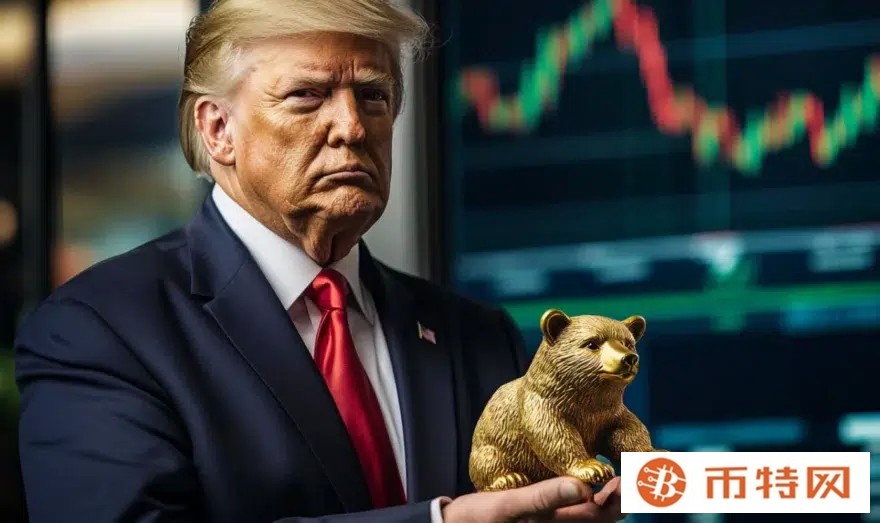
一天之内加密货币清算金额就达到 14 亿美元,这是否才刚刚开始,还是接近触底?
目录
As of Apr. 7, the global market environment has taken a sharp downturn, triggered by a single policy shift. On Apr. 2, President Donald Trump announced what he called “Liberation Day†tariffs — aggressive import duties that immediately shifted the tone in both equity and crypto markets.
Trump’s tariff regime has been sweeping. Imports from Canada and Mexico now face a 25% duty, while Chinese goods have been hit with an additional 34% tariff. In certain cases, products from other countries are facing combined tariffs climbing as high as 54%.
For Chinese imports, the layered effect of both new and existing tariffs means many goods are now entering the U.S. under an effective rate exceeding 54%.
The impact on the U.S. stock market was swift. By Apr. 4, the market had lost nearly $5.5 trillion in value in just two days. The S&P 500 alone shed $2.4 trillion on Apr. 3, followed by additional steep losses the next day.Â
In percentage terms, the Dow Jones dropped over 4,000 points, or 9.48%, the S&P 500 fell 10%, and the Nasdaq plunged 11% — all in a span of 48 hours.
Trump’s move was met with a fast response. On Apr. 4, China announced a 34% retaliatory tariff, escalating the situation and further straining market sentiment.
由此产生的波动影响到了全球市场。截至 4 月 7 日,美国主要指数的总损失估计在 6-7 万亿美元之间,具体数字仍在更新中。
芝加哥期权交易所波动率指数 (VIX),即华尔街的“恐慌指数”,飙升至多年以来的最高水平,到 4 月 7 日达到 60。自新冠疫情最严重时期以来,以及在此之前的 2008 年金融危机期间,VIX 飙升至近 80,这一水平从未见过。
美国以外的全球市场也受到重创。中国上证综指下跌逾 7%,日本日经指数下跌近 8%。债券市场也表现出压力,美国国债收益率趋于平缓,两年期国债收益率上升,十年期国债收益率下降。
波动并不仅限于股票。加密货币市场也受到了冲击,CoinGlass 的数据显示,截至 4 月 7 日,过去 24 小时内清算金额达 14 亿美元——这是近几个月来单日清算总额最高的一次。
比特币 (BTC) 下跌近 8% 至 76,500 美元,一度触及 74,400 美元附近的低点。以太坊 (ETH) 下跌 17% 至 1,500 美元的水平,短暂跌至 1,415 美元。其他主要山寨币也紧随其后:瑞波币 (XRP) 下跌 16%,目前交易价格约为 1.76 美元,而 Solana (SOL) 跌至 101 美元左右。
贝莱德首席执行官拉里芬克在致股东的一封信中将当前的环境描述为“普遍的经济焦虑”,并补充说,这种不可预测的关税举措使得试图评估全球供应链的企业“不可能”进行财务规划。
那么,究竟是什么推动了这波抛售潮?专家们如何解读未来走势?情况实际上还能恶化到什么程度?让我们仔细看看。
当关税上升时,进口商品的成本也会上升,这通常会导致通胀上升,尤其是当这些关税普遍存在并适用于主要贸易伙伴时。
特朗普的声明针对多个地区,再次引发了人们对全球贸易战的担忧。对于投资者来说,经济环境的这种转变改变了一切。
In times of economic uncertainty, riskier assets are usually the first to be sold. This includes stocks, but also crypto. Despite being often seen as independent from traditional markets, history shows that during periods of acute stress, digital assets tend to behave more like tech stocks than safe havens.
This pattern was clearly visible in early February, when a previous round of tariffs led to $2.2 billion in crypto liquidations, pushing Bitcoin down to $92,000. Now, this pattern is repeating, but on a larger scale.
Adding complexity to the situation is the interest rate outlook. In a slowing economy, the Federal Reserve would typically be expected to cut rates. However, tariffs complicate that playbook.Â
由于关税会导致通胀,因此限制了美联储的灵活性。如果通胀上升,央行可能被迫推迟预期的降息,甚至再次加息。
利率上升会降低流动性,这往往对投机市场伤害最大。加密货币是对流动性最敏感的资产类别之一,通常对这些变化反应强烈。
这正是机构情绪变得至关重要的地方。据广受关注的宏观通讯《Kobeissi Letter》报道,市场已进入恐惧开始占据主导地位的阶段。
Kobeissi 在 X 的一篇文章中指出,市场“失去了有序性”,资产全盘被抛售——包括黄金等传统避险资产,其价格一度跌至每盎司 3,000 美元以下。
这种大规模抛售通常表明市场正在进入投降阶段,投资者不再做出战略决策,而是专注于保住资本。
3 月份的数据显示,机构资本正以多年来最快的速度撤出美国股票,导致各类资产的流动性收紧,这支持了投资者情绪的转变。
随着资本退出股票市场,它并没有流入加密货币。相反,它转向短期现金工具和防御性投资。
我们所看到的抛售可能还不是最糟糕的。如果目前的趋势持续下去,报复如预期的那样升级,全球经济可能正走向十多年来最艰难的时期之一。
Let’s begin with trade. According to Oxford Economics, if all major U.S. trade partners respond with reciprocal tariffs, global trade volumes could shrink to levels not seen since the 2008 financial crisis, excluding the COVID-19 period.Â
This scenario is no longer hypothetical — China has already imposed a 34% retaliatory tariff, and further responses from the EU, Japan, and other major economies are widely expected.
The Tax Foundation estimates that Trump’s full tariff plan could result in a $1.8 trillion tax increase on American consumers. This could reduce U.S. imports by $900 billion in 2025, tightening supply chains and driving up the cost of goods across multiple sectors.
关税税率正在迅速接近历史水平。如果互惠政策继续实施,美国的平均关税税率可能会超过 33%,接近 20 世纪 30 年代的斯姆特-霍利关税法案时代——这被广泛视为加剧大萧条的因素之一。作为背景,自 1946 年以来,美国的平均关税水平从未超过 20%。
Key sectors are already under pressure. By midday on Apr. 4, Apple and Nike had lost $470 billion in combined market value, according to The Guardian.Â
Boeing shares dropped 10%, as disruptions ripple through aerospace supply chains, particularly with China and Vietnam, countries now facing tariffs of 52% and 46%, respectively.Â
Tech, retail, and manufacturing industries that rely on global sourcing are bearing the early weight of these policy changes.
The broader macro impact is beginning to take shape. JPMorgan has warned, in comments to CNN, of a potential U.S. and global recession in 2025 if these trade measures persist.Â
Investor Bill Ackman captured the market’s concern in a recent post, warning that business confidence is eroding quickly. While he supports reforming global trade imbalances, Ackman cautions that a full-scale, multi-front tariff approach is damaging America’s reputation as a stable trade partner.
阿克曼写道,如果特朗普继续不暂停政策,其结果可能是企业投资冻结、消费者支出崩溃、大规模裁员,尤其是对那些无力承受成本突然上涨的中小企业而言。
如果全球经济放缓真的成为现实——贸易萎缩、通胀上升和货币政策收紧——资本将继续从风险资产中流出。加密货币很可能位居榜首。
There’s little disagreement that we’re currently in a high-stress macro environment. According to crypto analysts, Bitcoin may face more short-term pain, but the long-term case for its role in a fragmented global economy is growing stronger.
Jamie Coutts, a chartered market technician and crypto strategist formerly at Bloomberg, highlights that Bitcoin is testing critical levels, specifically “the top of last year’s 7-month range,†as defined by on-chain metrics like exchange volumes and URPD (UTXO Realized Price Distribution).
库茨解释说,这一时刻的独特之处在于,比特币已成为唯一允许宏观投资者表达对不断升级的贸易战担忧的风险资产之一。
他说道:“当尘埃落定时,比特币将占据领先地位,因为世界将意识到它不仅仅是一种价值储存手段……它是一种专为贸易结算而构建的系统之外的资产。”
Coutts also cited a recent report from BlackRock, the world’s largest asset manager, which emphasized Bitcoin’s position as a “scarce, global, decentralized, non-sovereign asset.â€Â
While BlackRock stops short of calling it a settlement currency, it acknowledges Bitcoin’s clear hedging value in portfolios exposed to geopolitical and macroeconomic risks.
Meanwhile, Michaël van de Poppe, a well-known crypto trader and analyst, believes that panic-driven price movements are not over yet.
With Bitcoin down nearly 30% from its recent highs, he expects further testing of support levels, possibly as low as $70,000, especially if there’s no delay in tariffs or if the Federal Reserve doesn’t call for an emergency policy meeting.
However, van de Poppe also views these levels as potential long-term buying opportunities: “In 12–24 months from now, you’ll be happy that you’ve bought in these areas,†he said.
Others are framing the current price drop as a setup for a broader shift in narrative. Geoffrey Kendrick, global head of digital assets research at Standard Chartered, notes that Bitcoin could evolve into a hedge against tariff-induced risks.
In a note shared with The Block, he connected the growing U.S. isolationist stance to rising concerns about fiat exposure: “U.S. isolationism is akin to increased risks of holding fiat, which will ultimately benefit Bitcoin,†Kendrick wrote.
He identified $76,500 as a critical support level, marking the high from the day after the U.S. election, and emphasized Bitcoin’s relative strength compared to major tech stocks, aside from Microsoft and Google.
总而言之,虽然短期波动可能会持续,特别是关税升级影响利率预期和资本流动,但比特币的长期论点正在获得关注。
然而,谨慎仍然是必要的。如果关税进一步增加或通胀加速,比特币可能会与更广泛的市场一起面临新的压力。市场仍然高度不稳定,因此明智地交易很重要,并且永远不要投资超过你能承受的损失。